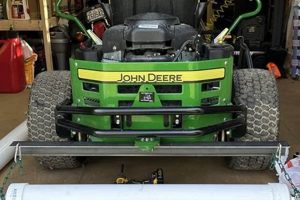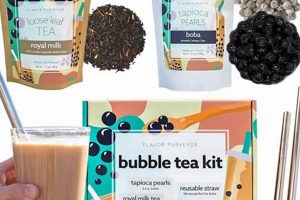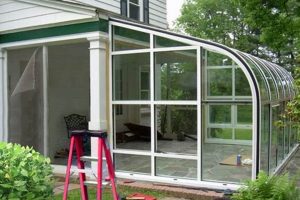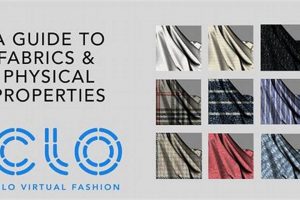A self-assembly enclosure for cultivating plants, typically in a sealed or semi-sealed glass container, represents a controlled environment for botanical growth. These sets frequently incorporate components such as a glass vessel, various types of substrate (e.g., soil, gravel), decorative elements (e.g., stones, figurines), and plant specimens suitable for thriving in a humid, contained space. For example, an individual might procure a package containing a glass jar, activated charcoal, potting mix, small ferns, and decorative moss to construct a miniature ecosystem.
The appeal of such a project lies in its ability to bring nature indoors, offering a calming aesthetic and a connection to the natural world. These miniature gardens promote mindful engagement and provide an educational opportunity to observe plant life cycles. Historically, the Wardian case, a precursor to the modern form, enabled the transportation of plants across continents by protecting them from harsh conditions during long voyages.
Subsequent sections will delve into selecting the optimal plants for contained ecosystems, guiding the assembly process to ensure successful establishment, and providing essential maintenance tips for long-term health and vibrant growth.
Guidance for a Successful Self-Assembled Enclosure
The following represents critical guidelines for maximizing the viability and aesthetic appeal of a constructed plant environment. Adherence to these principles will enhance the likelihood of long-term sustainability and minimize potential issues.
Tip 1: Substrate Stratification: Layering materials within the base is paramount for proper drainage and root health. A base layer of gravel facilitates water percolation, followed by activated charcoal to mitigate odor and filter impurities, and finally, a layer of appropriate growing medium suited to the selected plant species.
Tip 2: Plant Selection Criteria: Species appropriate for these environments tend to be slow-growing and require high humidity. Miniature ferns, mosses, and air plants are often suitable. Avoid plants that outgrow the enclosure rapidly or require significant airflow.
Tip 3: Controlled Hydration: Overwatering is a common cause of failure. The environment inherently retains moisture; therefore, water sparingly. Observe condensation levels to determine the need for additional irrigation. Misting is generally preferable to direct watering.
Tip 4: Strategic Placement: Position the enclosure in indirect light. Direct sunlight can cause excessive heat buildup, potentially damaging or killing the plant life within. Artificial grow lights may be considered if adequate natural light is unavailable.
Tip 5: Routine Ventilation: Even in sealed environments, periodic ventilation is beneficial to prevent the buildup of excessive humidity and stagnant air. Open the enclosure briefly once a week to facilitate air exchange.
Tip 6: Pruning and Maintenance: Regularly remove any dead or decaying plant matter to prevent the spread of disease and maintain aesthetic appeal. Prune plants as needed to control their size and shape within the limited space.
Tip 7: Pest Management: Inspect plants regularly for signs of pests. If infestation occurs, isolate the infected species immediately and treat with appropriate organic pest control methods, ensuring they are safe for use in enclosed environments.
By observing these recommendations, one can establish a thriving contained garden, promoting an aesthetically pleasing and biologically stable ecosystem within a limited space.
The subsequent section will summarize the key benefits and lasting appeal of engaging in the creation and maintenance of a self-contained green space.
1. Enclosure Selection
The choice of container is a foundational decision when assembling a self-contained ecosystem. The enclosure dictates the dimensions, aesthetics, and environmental control factors inherent to the entire unit. Selecting an appropriate vessel is not merely a stylistic choice but a determinant of the ecosystem’s long-term viability.
- Material Properties
The enclosure material significantly influences light transmission and heat retention. Glass, commonly employed, offers excellent clarity for photosynthetic activity. Plastic, while lighter and less fragile, may affect light quality and is less aesthetically appealing for some applications. The permeability of the material also impacts moisture retention within the assembled ecosystem.
- Shape and Accessibility
The physical shape of the container dictates the layout and accessibility for planting and maintenance. Wide-mouthed containers facilitate easier access for planting and pruning, while narrow-necked vessels create a more humid environment. The shape also influences the overall aesthetic, with spherical or geometric forms offering distinct visual appeals.
- Size Considerations
The size of the container directly correlates with the number and size of plants it can accommodate. Insufficient space restricts root growth and can lead to overcrowding, hindering the long-term health of the contained plants. Larger containers provide greater stability in terms of temperature and humidity fluctuations.
- Closed vs. Open Systems
The choice between a closed or open enclosure significantly alters the environmental dynamics. Closed systems, sealed from the external environment, maintain high humidity and require less frequent watering. Open systems allow for greater air circulation, reducing the risk of mold and fungal growth but necessitating more frequent hydration.
In essence, enclosure selection transcends simple preference; it is a critical design parameter impacting light exposure, humidity levels, and ease of maintenance within a miniature ecosystem. Skillful selection of the vessel constitutes a fundamental aspect of constructing a thriving self-contained botanical display.
2. Substrate Composition
Substrate composition within a self-assembly enclosure is not merely a layering of materials; it represents the foundational life support system for the plants within. The combination of components directly influences drainage, aeration, nutrient availability, and microbial activity, all of which are critical for plant health. A poorly chosen substrate can lead to root rot, nutrient deficiencies, and ultimately, the failure of the miniature ecosystem. For example, using standard garden soil, which retains excessive moisture, can quickly lead to anaerobic conditions detrimental to many plant species typically included in these botanical displays.
Effective substrate construction often involves a stratified approach, beginning with a drainage layer of gravel or pebbles to prevent waterlogging. This is typically followed b
y a layer of activated charcoal to filter impurities and reduce odors. Above this lies the growth medium, which may be a blend of peat moss, coco coir, perlite, and vermiculite, tailored to the specific moisture and nutrient requirements of the intended plant species. For instance, a substrate designed for succulents will differ significantly from one intended for moisture-loving ferns, reflecting the diverse needs of potential contents.
In summation, substrate composition is a critical determinant of success in constructing these plant environments. The selection and layering of materials have far-reaching effects on the health and sustainability of the enclosed ecosystem. Understanding these relationships is paramount for anyone engaging in the creation and maintenance of a self-assembled botanical display.
3. Plant Selection
The selection of appropriate flora is a critical determinant in the establishment and longevity of a thriving self-contained ecosystem. Compatibility with the restricted environment and interdependence with other selected elements within these environments dictate the overall success. Therefore, careful consideration must be given to species characteristics and their likely performance within a limited space.
- Size and Growth Rate
Species chosen must exhibit slow growth and remain diminutive in size. Plants that rapidly outgrow their allocated space necessitate frequent pruning or relocation, disrupting the delicate balance. Miniature ferns, mosses, and certain succulents represent examples of suitable selections. Plants such as fast-growing vines or large foliage varieties are generally inappropriate.
- Humidity and Moisture Requirements
Self-contained environments inherently maintain elevated humidity levels. Accordingly, species selected must be tolerant of high moisture and susceptible to neither fungal infections nor root rot under saturated conditions. Plants native to arid environments, for example, typically fare poorly unless the system is intentionally designed for lower humidity levels.
- Light Requirements
Species selected should thrive under filtered or low-intensity light conditions. Direct sunlight can lead to excessive heat buildup within the enclosure, potentially damaging the vegetation. Shade-tolerant species such as mosses, ferns, and certain low-light flowering plants are preferable, provided supplemental artificial lighting can be avoided or carefully managed.
- Compatibility and Symbiosis
Consideration of interspecies relationships is beneficial. Certain plants may compete for resources or inhibit the growth of others through allelopathy. Selecting species with complementary needs can promote a balanced ecosystem. For instance, pairing nitrogen-fixing plants with those requiring higher nitrogen levels can improve overall soil fertility.
The principles governing selection determine whether a self-contained plant display functions as a sustainable ecosystem or a short-lived novelty. Thoughtful species selection based on size, humidity tolerance, light requirements, and interspecies compatibility will increase the likelihood of creating a stable and aesthetically pleasing botanical display.
4. Drainage Layer
Within a self-assembled ecosystem, a basal stratum of coarse material serves as a critical component, facilitating water management. This layer mitigates the risk of waterlogged soil, a common cause of plant morbidity in enclosed environments. Its presence directly affects the root health and overall stability of the botanical display.
- Material Composition
Gravel, pebbles, or expanded clay aggregates typically constitute this basal level. These materials possess a high degree of porosity, permitting the free flow of excess water away from the root zone. The choice of material impacts the layer’s capacity to retain moisture and provide adequate aeration. For instance, larger gravel provides greater air circulation but may offer less moisture retention compared to smaller pebbles.
- Water Table Regulation
The stratum functions as a reservoir, accommodating excess water that drains from the soil above. This prevents prolonged contact between roots and saturated soil, reducing the likelihood of anaerobic conditions and subsequent root rot. The height and porosity of the layer determine its effectiveness in managing fluctuations in moisture levels.
- Microbial Environment
While primarily serving a physical function, the drainage layer also indirectly influences the microbial environment within the terrarium. Proper drainage inhibits the growth of anaerobic bacteria, which can produce harmful byproducts. A well-drained environment promotes the activity of beneficial aerobic microorganisms that contribute to nutrient cycling and plant health.
- Prevention of Soil Compaction
Over time, the soil can compact reducing aeration and drainage within the display. A drainage layer prevent a large amount of compaction since the layer itself is not easily compacted.
The drainage layer constitutes an essential element within the architecture of a self-contained plant display. Its properties directly influence water management, microbial activity, and root health, thereby impacting the overall sustainability and aesthetic appeal. Without this foundational component, the long-term viability of the ecosystem is compromised.
5. Humidity Control
Humidity control is a critical element in maintaining a balanced and thriving self-contained ecosystem. The equilibrium between moisture retention and ventilation directly affects the health and longevity of plant species within the closed environment. A lack of proper humidity management can lead to fungal growth, pest infestations, or desiccation of plant tissue, jeopardizing the entire display.
- Closed Versus Open Systems
The selection of a closed or open enclosure significantly impacts humidity management. Closed systems, characterized by sealed or partially sealed vessels, tend to retain higher humidity levels, necessitating careful monitoring to prevent excessive moisture buildup. Open systems, with greater air circulation, require more frequent hydration to counteract moisture loss. The type of enclosure selected dictates the subsequent humidity regulation strategies.
- Ventilation Strategies
Implementing ventilation strategies is crucial to controlling humidity levels within the enclosure. Periodic opening of a closed system allows for the exchange of air, reducing condensation and preventing the proliferation of fungal pathogens. The frequency and duration of ventilation depend on environmental factors, such as ambient temperature and humidity. Open systems may require strategically placed openings or small fans to promote air circulation without excessive dehydration.
- Substrate Composition and Moisture Retention
The composition of the substrate directly affects humidity levels. Components such as peat moss and vermiculite possess high water
retention capabilities, contributing to elevated humidity. Conversely, materials such as perlite and gravel promote drainage, reducing moisture retention. Careful selection and layering of substrate materials are essential for establishing a balanced moisture environment. The correct substrate can reduce the risk of over or under watering. - Plant Selection and Transpiration
Plant species selected for incorporation influence the overall humidity dynamics through transpiration. Plants with high transpiration rates release significant amounts of moisture into the environment, potentially increasing humidity levels. Choosing species with lower transpiration rates or those tolerant of elevated humidity can contribute to a more stable and manageable moisture balance. Leaf surface area and stomatal density correlate with transpiration rates and can inform species selection.
Effective humidity control within a self-contained ecosystem is a complex interplay of enclosure type, ventilation practices, substrate composition, and plant selection. Understanding and managing these interrelated factors is essential for creating a stable environment conducive to sustained plant growth and aesthetic appeal. Careful attention to humidity parameters enhances the likelihood of success in creating a miniature botanical display.
6. Lighting Conditions
Illumination represents a critical environmental parameter within a self-assembled plant enclosure. Photosynthesis, the fundamental process driving plant growth, relies on light energy. Consequently, manipulating lighting conditions influences plant health, morphology, and overall aesthetic appeal.
- Light Intensity and Plant Selection
The intensity of light reaching plants directly affects their ability to photosynthesize. Species vary widely in their light requirements, ranging from shade-tolerant varieties to those requiring intense illumination. Selection must correspond to the ambient light conditions or the provision of supplemental lighting. For example, a kit designed for low-light environments might include ferns and mosses, whereas one intended for a brighter location might incorporate succulents.
- Light Spectrum and Plant Development
The spectral composition of light, specifically the relative proportions of red and blue wavelengths, impacts plant development. Blue light promotes vegetative growth, while red light stimulates flowering. Artificial light sources, such as LED grow lights, offer the ability to tailor the light spectrum to optimize plant growth. A kit including flowering plants might benefit from a light source enriched in red wavelengths.
- Photoperiod and Circadian Rhythms
The duration of light exposure, or photoperiod, influences plant circadian rhythms, affecting flowering, dormancy, and other developmental processes. Manipulating the photoperiod can induce flowering in certain species. A kit designed to showcase seasonal changes might incorporate plants responsive to photoperiod cues, coupled with a timer-controlled light source.
- Light Distribution and Canopy Penetration
Uniform light distribution is essential for ensuring all plants within the enclosure receive adequate illumination. Overcrowding or shading from larger plants can limit light penetration, hindering the growth of smaller specimens. Strategic placement of plants and reflective surfaces can improve light distribution. Clear enclosure materials are essential to provide proper lighting conditions.
Therefore, deliberate management of illumination promotes sustained growth. By correlating light requirements, one is able to cultivate and sustain an environment favorable for the proliferation of plant life. Careful management of lighting conditions can influence the longevity and visual appeal of these botanical creations.
Frequently Asked Questions About DIY Terrarium Kits
The following addresses common inquiries and misconceptions surrounding the use and management of self-assembly plant enclosure systems. This information aims to provide clarity and assist in the successful establishment of these miniature ecosystems.
Question 1: What constitutes a typical set of materials within a self-assembly plant enclosure package?
A standard package generally includes a transparent container (glass or plastic), substrate components (drainage gravel, activated charcoal, potting mix), decorative elements (stones, moss), and plant specimens suited for enclosed environments. Specific contents may vary based on the intended plant species and aesthetic design.
Question 2: What is the expected lifespan of a properly maintained enclosure ecosystem?
With appropriate care, a well-constructed ecosystem can persist for several years. The lifespan depends on plant species, environmental conditions, and maintenance practices. Periodic pruning, pest control, and substrate replenishment may be necessary to prolong its viability.
Question 3: What types of plants are most suitable for use within a closed system?
Species tolerant of high humidity, low light, and limited space are most appropriate. Examples include miniature ferns, mosses, air plants, and certain slow-growing succulents. Avoid plants with high water demands or rapid growth rates.
Question 4: How frequently should an enclosed plant environment be watered?
Watering frequency depends on the specific environmental conditions and plant species. Generally, these systems require infrequent watering due to moisture retention within the enclosed space. Overwatering is a common cause of plant failure. Observe condensation levels and soil moisture to determine the need for hydration. Misting is preferable to direct watering.
Question 5: Is direct sunlight beneficial or detrimental to the contents of an enclosed plant display?
Direct sunlight can cause excessive heat buildup within the enclosure, potentially damaging or killing plants. Indirect or filtered light is preferable. Artificial grow lights may be employed if adequate natural light is unavailable, but care must be taken to prevent overheating.
Question 6: What measures should be taken to prevent or address pest infestations within the ecosystem?
Regular inspection of plants for signs of pests is crucial. Isolate infected specimens immediately. Treat infestations with appropriate organic pest control methods, ensuring they are safe for use in enclosed environments. Preventative measures include maintaining proper humidity and ventilation.
Proper selection of flora is key to the success of a self-contained plant display, coupled with adequate assessment of internal and external environmental needs.
The subsequent section will outline a step-by-step guide for constructing and assembling a self-contained plant display unit.
Concluding Remarks on Self-Assembly Botanical Enclosures
This article has presented a comprehensive exploration of the construction and maintenance of self-contained plant displays. Emphasis has been placed on critical parameters such as substrate composition, appropriate flora selection, and the importance of humidity and lighting control. The information presented serves as a practical guide for individuals seeking to create sustainable and aesthetically pleasing miniature ecosystems.
The ability to construct and sustain these enclosed environments represents a convergence of
horticultural knowledge and artistic expression. By understanding the fundamental principles outlined herein, practitioners can cultivate long-lasting botanical displays, contributing to an appreciation for ecological balance and the integration of nature within interior spaces. Further exploration of advanced techniques and plant species will undoubtedly yield innovative approaches to enclosed ecosystem design and management.







